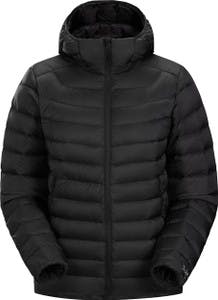Women's down and puffer jackets
- (5)Patagonia Down Sweater Hoody - Women's$409.00
- (0)Kari Traa Tirill Thermal Jacket - Women's$274.95
- (59)Arc'teryx Cerium Hoody - Women's$500.00
- (0)Rab Electron Pro Hoody - Women's$474.95
- (10)Fjallraven Expedition Down Lite Jacket - Women's$724.95
- (7)Arc'teryx Patera Parka - Women's$950.00
- (1)MEC Boundary Light Down Hooded Jacket - Women's$269.95
- (2)MEC Icefields Down Hooded - Women's$329.95
- (4)Patagonia Down Sweater - Women's$349.00
- (6403)The North Face Arctic Parka - Women's$459.99
- (22)MEC Tremblant Jacket - Women's$269.95
- (9)Black Diamond Access Down 2.0 Hoody - Women's$409.95
- (138)Arc'teryx Thorium AR Hoody - Women's$480.00$600.00
- (89)Outdoor Research Snowcrew Jacket - Women's$337.46$449.95
- (0)Kathmandu Epiq SE Women's Down Hooded Jacket - Women's$349.95
- (0)Patagonia Fitz Roy Down Hoody - Women's$499.00
- (9)The North Face MTN Range Down Parka - Women's$529.99
- (5)The North Face Hydrenalite City Long Down Hooded Parka - Women's$469.99
- (270)Outdoor Research Helium Down Hoodie - Women's$314.96$419.95
- (146)Rab Microlight Alpine Jacket - Women's$349.95
- (11)MEC Boundary Light Down Jacket - Women's$249.95
- (29)Arc'teryx Cerium Hoody - Women's$500.00
- (0)Arc'teryx Cerium Jacket - Women's$360.00$450.00
- (144)Outdoor Research SuperStrand LT Hoodie - Women's$224.96$299.95
- (11)MEC Tremblant Long Jacket - Women's$319.95
- (54)Outdoor Research Coldfront Down Jacket - Women's$224.96$299.95
- (1)Patagonia Jackson Glacier Parka - Women's$625.00
- (10)The North Face Hydrenalite City Down Hooded Parka - Women's$399.99
- (1)Indyeva Maco Parka Jacket - Women's$697.95
- (22)MEC Guides Down Parka - Women's$449.95
- (0)Indyeva Mirny Winter Jacket - Women's$497.95
- (9)The North Face Summit Breithorn Hoodie - Women's$549.99
- (0)Indyeva Dolu Jacket - Women's$337.95
- (0)MEC Bromont Recycled Down Jacket - Women's$469.95
- (2)Rab Electron Pro Jacket - Women's$484.95
- ‹
- 1
- ›
Compare (0)
Women’s down jackets and puffers
Down insulation is made up of thousands of fluffy plumules from goose or duck feathers. It offers an unbeatable warmth and lightness and compresses well so you can stash it in a small corner of your pack when not needed.
Why choose a down jacket over synthetics?
It’s the best choice for cold, dry days in winter, for alpine missions and for hut trips – when you want a lightweight option, and the conditions aren’t too rainy. Down can clump and lose its insulating power when wet, so the trick to staying warm with down is keeping it dry.
As a sustainable bonus, the fill in all MEC Label down jackets and other brands including [Patagonia](/ en/products/brands/patagonia/clothing/jackets/insulated-jackets/down-insulated-jackets?gender=womens) and Indyeva, is sourced through the Responsible Down Standard and the fabrics are made using [recycled content].(/en/explore/recycled-fibres)
Down parkas and combination fills
Synthetic–insulated jackets are a little heavier and not as compressible as down, but they do retain warmth when wet. Some outdoor jackets use synthetics in the hood and shoulders where the insulation is most exposed to wetness. You’ll also find down-insulated winter coats and parkasthat use waterproof-breathable fabrics to protect the down. These jackets aren’t ultralight, but they are stormproof and a great choice to wear through winter in urban settings.
About down fill-power
Fill-power helps you assess the quality of the down plumage. High numbers indicate better quality – essentially more fluffiness, and therefore more warmth for the weight. Fill-powers from 550 to 850 range from good to excellent. But fill-power alone isn’t what makes a jacket the warmest. Look for a measurement of down weight, which tells you how many grams of down are used. Lots of down makes a jacket warm. Lots of high-fill-power down makes a jacket warm and light.
Is an ultralight down jacket the best choice?
Climbers, backcountry skiers, and thru-hikers who count every gram, will seek out the lightest possible puffers from mountain brands like Patagonia, Arc’teryx and Outdoor Research. But ultralight fabrics (20-denier and under) add expense and are thin enough to require delicate handling. For versatility, a down jacket with a 20 to 50-denier face fabric will be less likely to tear and still be wonderfully lightweight. MEC offers great options in this category.
Washing and repairing a down jacket
To help retain the warmth and loft of your puffy coat, you can hand wash it at home – and restore any water repellency while you’re at it. See how to wash a down jacket. If you spot a small tear, tape and fabric patches might be the DIY fix you need.



































